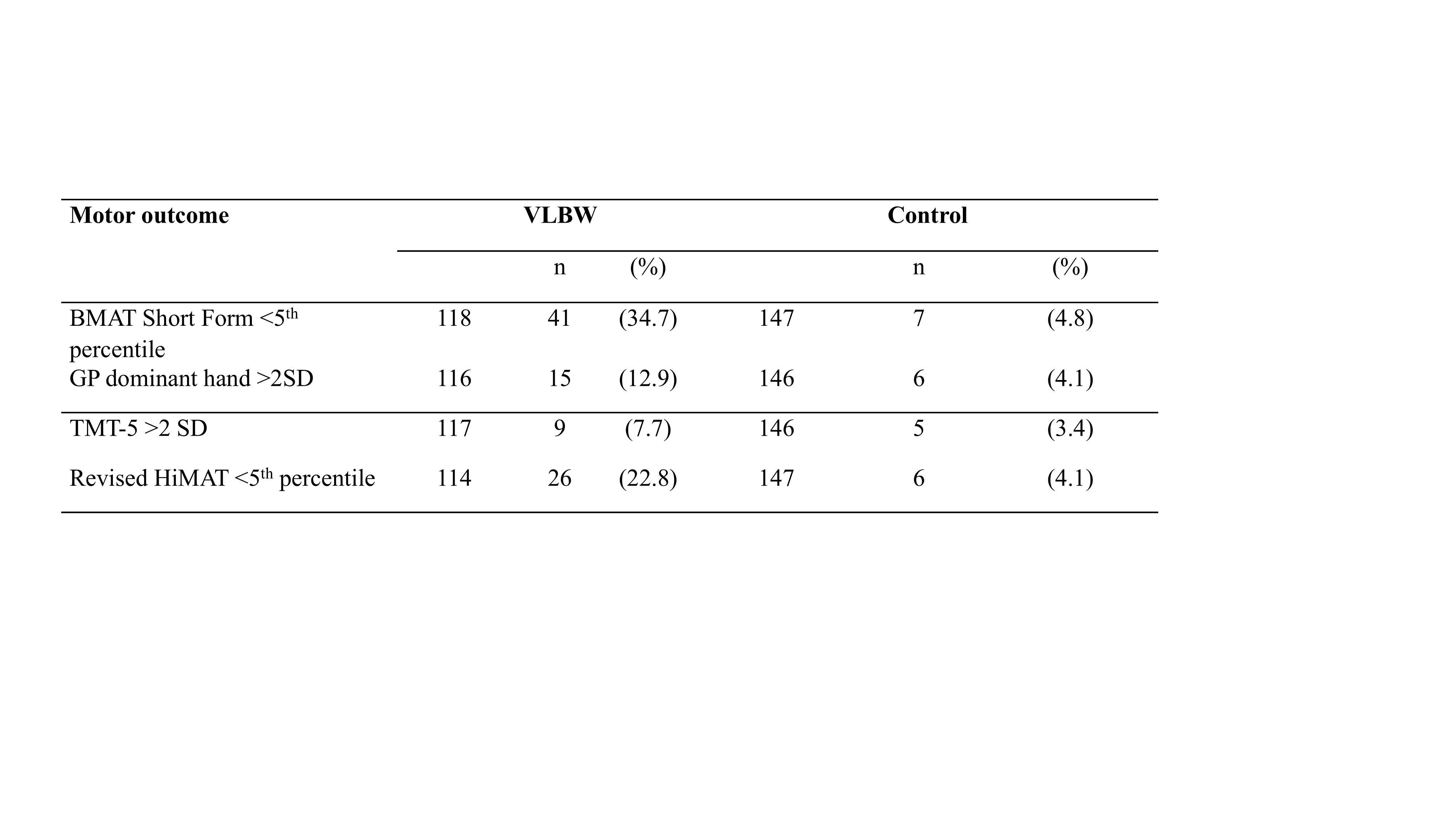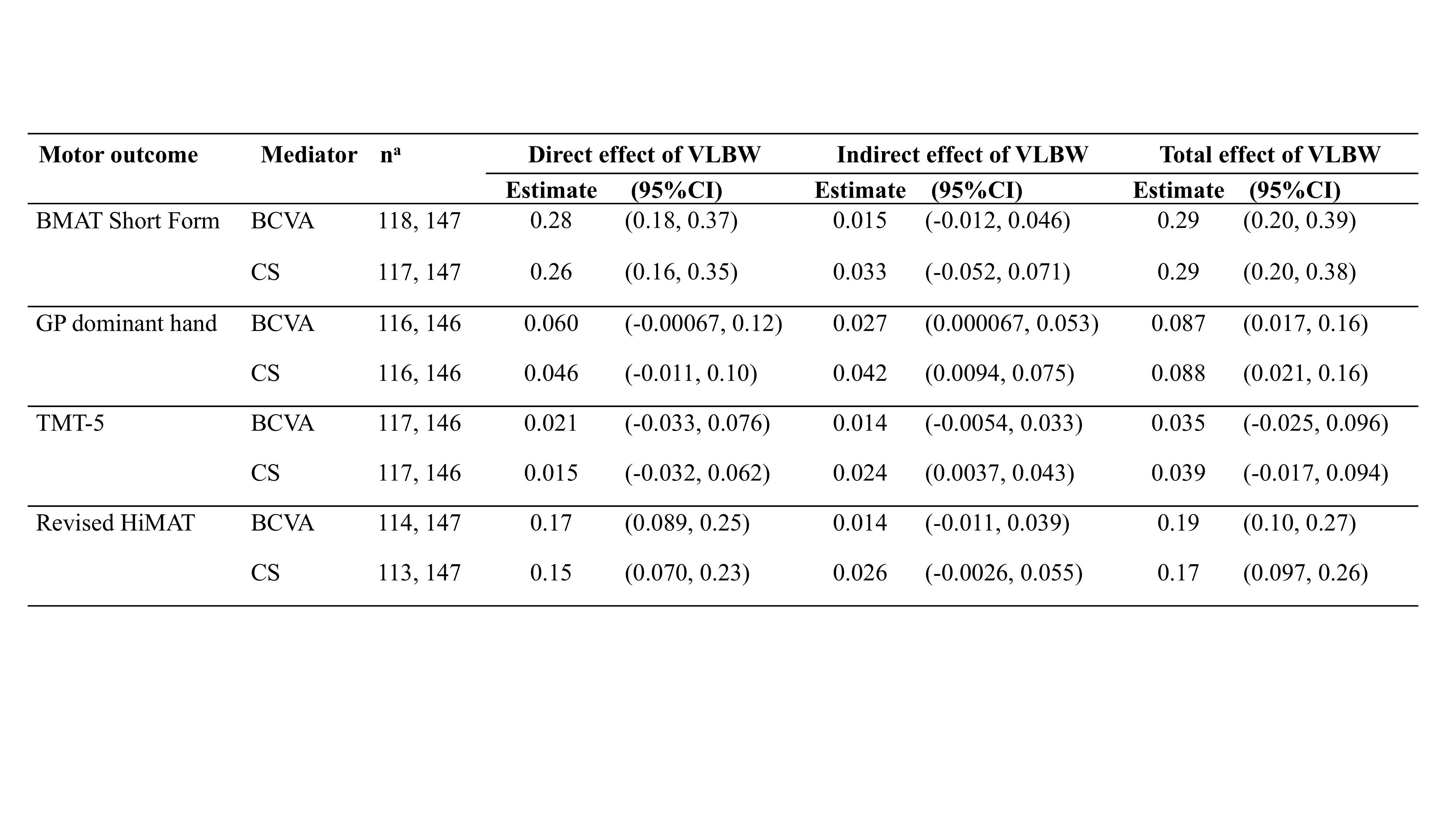Neonatal Follow-Up 3: Long-Term Outcomes in NICU Graduates
Session: Neonatal Follow-Up 3: Long-Term Outcomes in NICU Graduates
586 - Motor Difficulties and Visual Function in Adults Born Preterm with Very Low Birth Weight
Monday, April 28, 2025
7:00am - 9:15am HST
Publication Number: 586.5867
Silje Dahl Benum, Norwegian University of Science and Technology, Trondheim, Sor-Trondelag, Norway; Anna Fivelstad, Norwegian University of Science and Technology, Trondheim, Sor-Trondelag, Norway; Urd E.. Svennevig, NTNU, Trondheim, Sor-Trondelag, Norway; Anna Perregaard Munch Jørgensen, NTNU, Trondheim, Sor-Trondelag, Norway; Maarit K. Kulmala, FInnish Institute for Health and Welfare, Helsinki University Hospital, Espoo, Uusimaa, Finland; Kristina Anna Djupvik Aakvik, Norwegian University of Science and Technology, Trondheim, Sor-Trondelag, Norway; Stian Lydersen, Norwegian University of Science and Technology, Trondheim, Sor-Trondelag, Norway; Anna Majander, Helsinki University Hospital, Helsinki, Uusimaa, Finland; Tora Sund Morken, NTNU, Trondheim, Sor-Trondelag, Norway; Eero Kajantie, Finnish Institute for Health and Welfare and University of Oulu, Helsinki, Uusimaa, Finland; Kari Anne I. Evensen, Norwegian University of Science and Technology, Trondheim, Sor-Trondelag, Norway
.jpg)
Kari Anne Evensen, PhD
Professor
Norwegian University of Science and Technology
Trondheim, Sor-Trondelag, Norway
Presenting Author(s)
Background: Children and adolescents born with very low birth weight (VLBW≤1500g) have increased prevalences of both motor and visual difficulties. However, it remains unknown if there is an association between VLBW and risk of having motor difficulties in adulthood, and if the association is mediated by visual function.
Objective: To examine whether VLBW is associated with risk of having motor difficulties in mid-adulthood and, if so, whether the association is mediated by visual function.
Design/Methods: In a joint follow-up of two prospective cohort studies from Finland and Norway, 118 adults born with VLBW (mean age 36.2, SD3.2) and 147 term-born controls (mean age 35.8, SD3.2) were assessed. Overall motor abilities were assessed using the Bruininks Motor Ability Test (BMAT) Short Form, gross motor abilities using the Revised High-level Mobility Assessment Tool (HiMAT) and fine motor abilities using the Grooved Pegboard (GP) and Trail Making Test-5 (TMT-5). Visual assessments included best-corrected visual acuity (BCVA) and contrast sensitivity (CS). Motor difficulties was defined as scores < 5th percentile in the control group for BMAT and HiMAT, and >2SD for GP and TMT-5. We used the “mediate” feature in Stata 18 to investigate the casual pathway from VLBW to motor difficulties with visual function as mediators. Effects are reported as risk differences, adjusted for cohort, age and sex.
Results: Proportions of overall and gross motor difficulties in the VLBW group were 34.7% on BMAT Short Form and 22.8% on Revised HiMAT compared with 4.8% and 4.1% in the control group (Table 1). Proportions of fine motor difficulties in the VLBW group were 12.9% on GP and 7.7% on TMT-5 compared with 4.1% and 3.4% in the control group. The total effect of VLBW on BMAT Short Form and Revised HiMAT were 0.29 (95%CI: 0.20, 0.39) and 0.19 (95%CI: 0.10, 0.27), and not mediated through the visual variables (Table 2). The total effect of VLBW on GP was 0.09 (95%CI: 0.02, 0.16) and mediated through BCVA (0.03; 95%CI: 0.0001, 0.05) and CS (0.04; 95%CI: 0.009, 0.08). The total effect of VLBW on TMT-5 was 0.04 (95%CI: -0.02, 0.09) and mediated through CS 0.02 (95%CI: 0.004, 0.04).
Conclusion(s): Adults born with VLBW had more motor difficulties than controls on all motor tests. Visual function and especially contrast sensitivity mediated the association between VLBW and fine motor difficulties, but not overall and gross motor difficulties. This indicates that vision influences especially fine motor function, which may be important for academic and professional life in mid-adulthood.
Table 1. Proportions of participants with motor difficulties defined by a score below the 5th percentile or above 2 SD on the motor assessments in the VLBW and control groups.
 Abbreviations: BMAT, Bruininks Motor Ability Test; GP, Grooved Pegboard; HiMAT, High-level Mobility Assessment Tool; SD, standard deviation; TMT-5, Trail Making Test-5; VLBW, very low birth weight.
Abbreviations: BMAT, Bruininks Motor Ability Test; GP, Grooved Pegboard; HiMAT, High-level Mobility Assessment Tool; SD, standard deviation; TMT-5, Trail Making Test-5; VLBW, very low birth weight.Table 2. Effect of VLBW versus control on motor difficulties with visual function as mediators, given as risk differences, adjusted for cohort, age and sex.
 a VLBW, Control
a VLBW, ControlAbbreviation: BCVA, best-corrected visual acuity; BMAT, Bruininks Motor Ability Test; CI, confidence interval; CS, contrast sensitivity GP, Grooved Pegboard; HiMAT, High-level Mobility Assessment Tool; TMT-5, Trail Making Test-5; VLBW, very low birth weight.

